Results 4,201 to 4,210 of 8437
Thread Information
Users Browsing this Thread
There are currently 2 users browsing this thread. (0 members and 2 guests)
-
09-08-2013, 08:12 AM #4201Senior Member


- Join Date
- May 2007
- Location
- South West Florida (Behind friendly lines but still in Occupied Territory)
- Posts
- 117,696

 DIY Home Decorating
DIY Home Decorating
TIP: save space by going vertical with your laundry baskets!
More at: www.diycozyhome.com
Follow Us! ---> DIY Home DecoratingJoin our efforts to Secure America's Borders and End Illegal Immigration by Joining ALIPAC's E-Mail Alerts network (CLICK HERE)
-
09-08-2013, 08:13 AM #4202Senior Member


- Join Date
- May 2007
- Location
- South West Florida (Behind friendly lines but still in Occupied Territory)
- Posts
- 117,696

 DIY Home Decorating
DIY Home Decorating
Easy DIY Door Casings!
instructions ---> http://diycozyhome.com/easy-diy-door-casings/
Follow Us! ---> DIY Home DecoratingJoin our efforts to Secure America's Borders and End Illegal Immigration by Joining ALIPAC's E-Mail Alerts network (CLICK HERE)
-
09-08-2013, 08:14 AM #4203Senior Member


- Join Date
- May 2007
- Location
- South West Florida (Behind friendly lines but still in Occupied Territory)
- Posts
- 117,696

 DIY Home Decorating
DIY Home Decorating
Fun Kitchen Table and Chairs Makeover!
more info: ---> http://diycozyhome.com/fun-kitchen-t...airs-makeover/
Follow Us! ---> DIY Home DecoratingJoin our efforts to Secure America's Borders and End Illegal Immigration by Joining ALIPAC's E-Mail Alerts network (CLICK HERE)
-
09-08-2013, 05:32 PM #4204Senior Member


- Join Date
- May 2007
- Location
- South West Florida (Behind friendly lines but still in Occupied Territory)
- Posts
- 117,696

 Homestead Survival
Homestead Survival
http://thehomesteadsurvival.com/doit.../#.UiN4QFfHa3g
Pole Barn Building Build It Yourself ProjectJoin our efforts to Secure America's Borders and End Illegal Immigration by Joining ALIPAC's E-Mail Alerts network (CLICK HERE)
-
09-12-2013, 08:23 PM #4205Senior Member


- Join Date
- May 2007
- Location
- South West Florida (Behind friendly lines but still in Occupied Territory)
- Posts
- 117,696

 DIY Home Decorating
DIY Home Decorating
RECYCLE... cinder block planter!
25 more creative planters ---> http://diycozyhome.com/25-small-urba...-design-ideas/
Follow Us! ---> DIY Home DecoratingJoin our efforts to Secure America's Borders and End Illegal Immigration by Joining ALIPAC's E-Mail Alerts network (CLICK HERE)
-
09-12-2013, 08:25 PM #4206Senior Member


- Join Date
- May 2007
- Location
- South West Florida (Behind friendly lines but still in Occupied Territory)
- Posts
- 117,696

 DIY Home Decorating
DIY Home Decorating
DIY Shoe Storage Plans!
---> http://diycozyhome.com/ballard-desig...storage-plans/
Follow Us! ---> DIY Home DecoratingJoin our efforts to Secure America's Borders and End Illegal Immigration by Joining ALIPAC's E-Mail Alerts network (CLICK HERE)
-
09-12-2013, 08:27 PM #4207Senior Member


- Join Date
- May 2007
- Location
- South West Florida (Behind friendly lines but still in Occupied Territory)
- Posts
- 117,696

 DIY Home Decorating
DIY Home Decorating
DIY Garden Chandelier!
more ideas: http://diycozyhome.com/101-ways-to-d...th-mason-jars/
Follow Us! ---> DIY Home DecoratingJoin our efforts to Secure America's Borders and End Illegal Immigration by Joining ALIPAC's E-Mail Alerts network (CLICK HERE)
-
09-12-2013, 08:35 PM #4208Senior Member


- Join Date
- May 2007
- Location
- South West Florida (Behind friendly lines but still in Occupied Territory)
- Posts
- 117,696
6 Trees Every Survivalist Should Know & Why
September 9, 2013 By Creek 17 Comments
Now is a good time to go out and flag the following five trees before the leaves drop (except the pine). Revisit them in the winter and learn how to ID them by the bark alone. Then again in the Spring with the buds and new leaves.
White birch (paper birch)

White birch is easy to identify with its distinctive, white, papery bark. The sycamore tree also has white bark, but it does not sluff off in thin, paper-like furls like the white birch. The sycamore also has large hand-shaped leaves versus the white birch’s smaller, oval-shaped leaves with a pointed tip. The birch leaf is also irregularly toothed. These grow almost exclusively in northern climates.
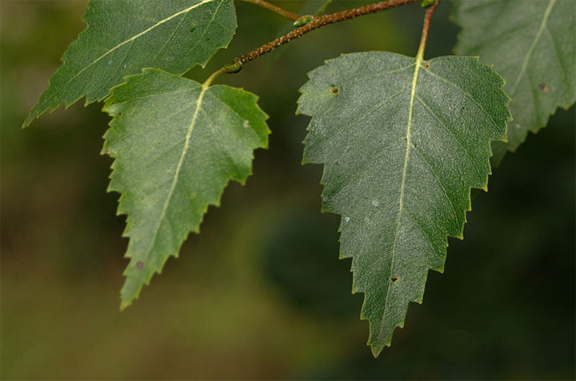
White birch survival uses:
- Sweet drinkable sap that does not need purification
- Containers can be fashioned from the bark (and even canoes – hence the name “canoe birch”)
- It’s papery bark makes some of the finest fire starting tender on the planet, which will light even when damp because of its resinous quality
- A fine tea can be made from the small twigs at the end of a branch or by shaving the bark from new growth. Toss a palmful of these elements into boiling water for a fresh, wintergreen-flavored tea
- The tinder fungus (chaga) grows almost exclusively on the white birch tree. The fungus is one of the only natural materials I know of that will take the spark from flint and steel. A piece of tinder fungus along with flint and pyrite to create sparks were even found on Otzi, the “iceman” who was uncovered in the Austrian Alps several years ago.
- Pine tar can be extracted from the bark of the white birch by heating it over a fire. Pine tar makes an excellent natural adhesive which natives used for all kinds of purposes including securing stone points on arrows.
American Basswood

The American basswood (also called American linden) is a very common tree – especially in the Eastern U.S. It prefers moist soil and is often found by creeks, streams and ponds. It likes to grow several shoots from the base so it’s not uncommon to see the basswood growing in what appears to be clumps. Basswood trees have large, heart-shaped, coarsely toothed leaves and dark red young leaf buds. One of the most distinctive features of the basswood is what I call the “tongue.” A tongue-shaped leaf grows at the base of the regular heart-shaped leaves on mature trees. Hard, little, nut-like fruits dangle from the center of this “tongue” leaf throughout the summer.
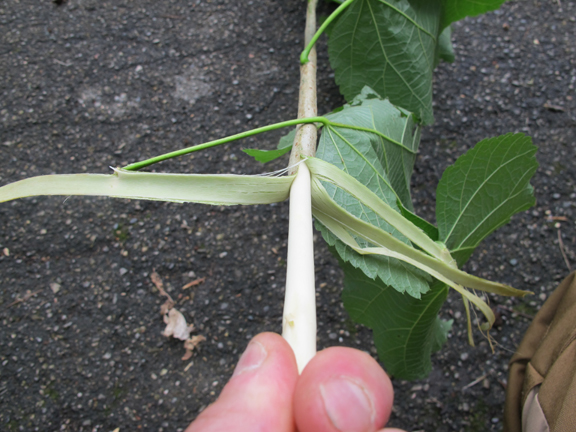
Basswood survival uses:
- Delicious edible leaves – especially in spring
- “Bass” comes from the word “bast,” which is an old word for rope. The inner fibers from the Basswood make some of the best natural cordage on the planet. In my last course, 2 adult men could not break a 1/2″ thick strip of basswood bark.
- Basswood is my favorite wood to use in fire by friction sets. It is soft and makes a perfect friction fire wood for bow drill spindles and hearthboards and for hand drill hearthboards.
- Basswood is preferred by most wood carvers and chainsaw carvers because of how easy it is to work and carve
- Inner bark layer is edible and can be scraped off with the edge of your knife. It has a very sweet flavor.

White Pine
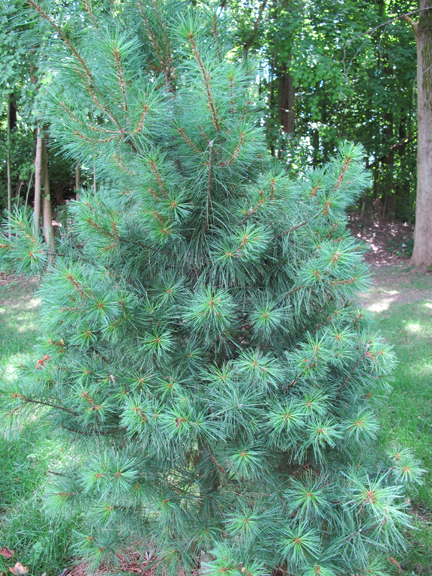
The leaves of the White Pine grow in batches of 5 needles. Every fall the white pine loses all of its needles except those that grew that year. Pine is an evergreen. Evergreen trees keep some green leaves year-round, unlike deciduous trees, and have needle-like leaves. They also produce cones (pine cones) instead of flowers.
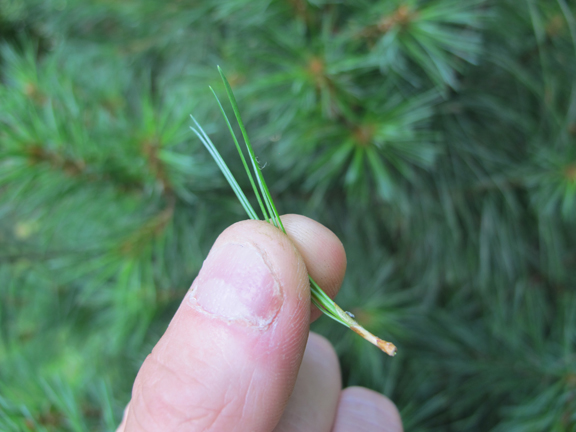
White pine survival uses:
- Resin can be used a fire extender when mixed with tinder material
- Resin can be heated and mixed with crushed charcoal to make a natural epoxy
- Resin-rich joints and stump pieces make incredible fire kindling
- Make pine-needle tea from the green pine needles – very rich in Vitamin C
- Inner bark layers are edible
- Harvest pine nuts from the pine cones
- Pine needles make excellent fire tinder
- Pine needles make excellent natural insulation material for debris huts and survival shelters
- Green pine boughs are perfect for lean-to shelter roofs
- Green pine boughs are great for making a ‘pine bough bed’ to protect from the cold ground or snow
- The lower, dry, dead branches of the pine tree (squaw wood) is often some of the driest fire kindling available. It is exposed to the wind and also protected from the elements by the year-round needle canopy above, I’ve also used these branches for making bow drill fire friction sets.
- Very effective candles and lamps can be made from pine resin
- Pine resin can be used to waterproof seams in clothing or crude containers
- The very pliable surface layer roots make excellent (and strong) natural cordage. Use as a whole or split into smaller pieces.
White Oak (and all oaks in general)

White oaks have rounded leaf lobes instead of pointed ones like red oaks. Contrary to popular belief, acorns are edible. I like white oak acorns better because it seems they are less bitter and it takes less effort to leach out the tannic acid (which causes this bitterness) to become more palatable. An abundance of acorns in mid-summer makes the oak family almost impossible to misidentify. Oaks are some of the largest trees in the forest. I have many white oaks at Willow Haven that are over 100 feet tall and easily 3-4 feet in diameter.
White oak survival uses:
- Acorns (after leaching out the tannic acid) can be ground and used as flour to make acorn bread
- Tannic acid (which can be extracted by boiling or leaching acorns and/or inner oak bark and twigs) is anti-bacterial. I’ve used it as an antiseptic wash before and have heard of it being used to quell diarrhea.
- Acorns can be used a trap bait for squirrel and other small game animals
- Can tan leather using the tannic acid found in bark, acorns and wood
- Oak is a very hard wood that is good for ax handles, digging sticks and shelter frameworks
- When dried, the white oak flowers make suitable tinder bundles and can be found in great abundance certain times of the year
Sugar Maple (and pretty much all maples)

The sugar maple is one of my favorite trees and probably one of the most popular in the Eastern woodlands. Its beauty is on full display when the leaves change each fall into bursts of red, orange and yellow. The leaves usually have five lobes, and the tips are pointed. Young maples have smooth silvery bark. The unmistakable, “winged helicopter” seeds are a tell-tale maple tree indicator. Sugar maple is the source for maple syrup. This tree is preferred because its sap has high sugar content. It takes 40 gallons of sugar maple sap to make 1 gallon of maple syrup.

Sugar maple survival uses:
- In later winter/early spring when the sap is running, the sugar maple is an excellent source of drinkable water (sap) that needs no purification. Maple Sap is nature’s version of an energy drink – rich in sugar and nutrients. I’ve filled a 1-liter canteen in as few as 15 minutes before. Maples don’t have fully developed (or any) leaves during this time of year – hence the important of 4 season identification.
- The seeds inside the little helicopters are edible, just like edamame. I just boil them and lightly salt. They can also be fried or added to stews. Remove the outer helicopter.
- I almost always use maple branches for wilderness cooking. Whether it’s a spit roast, a hot dog stick or utensils, I can always find a maple branch suitable for the task. Maple branches naturally have a lot of forks, which is great for pot holders and other wilderness kitchen uses. I also use the leaves to wrap fish or other small game animals when cooling in an earth oven.
- Young maple leaves are also edible. Toss them into a salad or boil them down with other spring greens. They get bitter and rough as they mature.
Willow Tree

There are tons of different willow varieties. Every willow I’ve seen has a similar leaf shape. The leaves are narrow, lance-shaped and grow in great numbers along the branches. Willows must be in moist areas to survive. If you’ve found a willow, then there is a water source nearby.
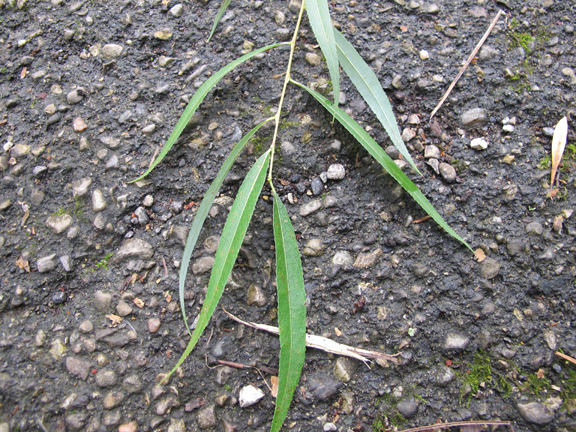
Willow survival uses:
- Willow bark contains a chemical called salicin, which is similar to aspirin. I can personally attest to its effectiveness in relieving headaches and inflammation. Just chew on a few small green twigs and swallow the juices.
- In spring and summer, willow bark will peel away from the wood and makes excellent cordage that can be used for a huge variety of tasks.
- Young willow branches and saplings are very flexible and can be used to weave a variety of different baskets and funnel traps.
- I’ve used dried willow wood on many occasions for friction fire sets – both hand drill and bow drill
- Willow saplings make excellent frog and fish gigs. Just split the base into 4 equal sections, press a rock to the bottom of the splits and sharpen the tines.
Feel free to list other uses for these trees that I may have overlooked in the comments below!
Remember, it’s not IF, but WHEN.
Similar Posts:
- I’d Tap That! (Maple Tree that is.)
- How to Make a Quick Bushcraft Trail Fork
- How To Make Pine Resin Glue
- Now all I need is some camel hair, a girdle of skin about my loins and some locusts…
- The Ultimate Survival Training Ground: Your BACK YARD
About Willow Haven Outdoor & Creek StewartCreek Stewart is the Owner and Lead Instructor at Willow Haven Outdoor - a leading Survival and Preparedness Training Facility located on 21-acres in Central Indiana. For more information on Survival Courses and Clinics offered at WHO, click HERE. Creek is also author of Build the Perfect Bug Out Bag: Your 72-Hour Disaster Survival Kit and The Unofficial Hunger Games Wilderness Survival Guide. You can contact Creek directly at creek@willowhavenoutdoor.com.
http://willowhavenoutdoor.com/featur...ould-know-why/Join our efforts to Secure America's Borders and End Illegal Immigration by Joining ALIPAC's E-Mail Alerts network (CLICK HERE)
-
09-12-2013, 08:45 PM #4209Senior Member


- Join Date
- May 2007
- Location
- South West Florida (Behind friendly lines but still in Occupied Territory)
- Posts
- 117,696
Rice And Beans, A Survival Combination
Sunday, September 8, 2013 10:03
(Before It's News)
September 7, 2013, by Ken Jorgustin

Rice is rich in starch, and an excellent source of energy. Beans are rich in protein, and contain other minerals. The consumption of the two together provides all the essential amino acids and it is no wonder that this combination is a staple of many diets throughout the world.
Here’s why they are an excellent combination for long-term survival food starge…
Although you will likely add additional ingredients with rice and beans, having just…
(1) 5-gallon pail of white rice
(1) 5-gallon pail of pinto beans
…will provide 44 days of ‘survival’ calories. That’s a month and a half worth of food!
Sure, you won’t want to eat rice and beans every day, every meal, and the recommended practice for building food storage for survival preparedness is to diversify…
However, it is wise to consider securing a basic supply of rice and beans, properly packed and stored for long term storage, so that you will have a ready inventory of ‘fall-back’ food storage. It is cheap, healthy enough, and will last for many years if stored properly.
There are lots of other foods and spices that can be easily and tastily added to rice and beans, making it a very good base for meals – a base that could technically sustain you even if that’s all you had to eat.
Consider buying yourself some bulk rice and beans, and store them properly, just in case.
Long Grain White Rice – Nutrition Per Cup, Raw
675 calories per cup (uncooked)
1,485 calories per pound
45,000 calories in a 5 gallon pail (about 30 pounds), 22 survival days
Fat (1.2 grams)
Carbohydrates (148 grams)
Fiber (2.4 grams)
Protein (13.2 grams)
Very low in saturated fat
No cholesterol
Very low in sodium
Very low in sugar
High in manganese
Read More
http://beforeitsnews.com/survival/20...n-2488218.htmlJoin our efforts to Secure America's Borders and End Illegal Immigration by Joining ALIPAC's E-Mail Alerts network (CLICK HERE)
-
09-12-2013, 08:54 PM #4210Senior Member


- Join Date
- May 2007
- Location
- South West Florida (Behind friendly lines but still in Occupied Territory)
- Posts
- 117,696
What if you had to Evacuate?
Saturday, September 7, 2013 18:05
(Before It's News)
[Nyerges has led survival skills and wild food classes since 1974, was the editor of Wilderness Way magazine for 7 years, has written 10 books* (including “How to Survive Anywhere,” “Guide to Wild Foods,” “Self-Sufficient Home,” and others). He can be heard weekly on Preparedness Radio Network.* For more information, go to www.ChristopherNyerges.com]
During one of my Pasadena City College survival classes, a student asked me to list the items that should be carried in an evacuation bag, also known as the “bugout bag.”* In other words, if she had to immediately leave her home for some reason, what should her survival bag contain.* Of course, this led to a big portion of that evening’s discussion.
“First,” I responded, “what scenario are we talking about?” The student was thinking of a serious emergency where even a car wouldn’t be useful, where you’d have to evacuate on foot.
So my first order was to convey the fact that one would rarely choose to leave one’s home – where everything is familiar and where you know everyone in the neighborhood – unless you absolutely had no other choice.*
“You would rarely want to choose to leave your home and randomly wander the streets after an emergency,” I replied, “because you are now entering into the chaos and randomness of street mobs and possible violence.”* I tried to impress upon the class how dangerous it often is to wander on foot in the aftermath of a major disaster – whether it be an earthquake, or the results of war, or flooding.
And though the effects of nature can be devastating, the fear and chaos that will possess other people could be your greatest threat.
OK, we established that wandering around may not be your best choice but if you have no choice, then what should you carry?
Before I tried to answer that question, I asked all the students, “If there was an emergency tonight after you get home and you had to evacuate, where would you go?* And why would you go there?”* Most had no idea where to do, and in all probability, would follow crowds to some likely safe place, or would simply follow the orders of whomever happened to be giving orders.*
I urged each student to obtain topographical maps of their local area and to begin to learn about their local environment.* Find out where there are sources of water, reservoirs, pools, train lines, etc.* In a disaster, your knowledge is far more important than your stuff.*
Next, I urged each student to get involved in their local Neighborhood Watch, and to do the CERT trainings, and Red Cross emergency first aid.* In other words, we need to realize the fact that other people in our community, and our relationships with them, is a far greater “survival tool” than merely having a pack with some knick-knacks in it.
Most people would be surprised to learn the level of preparedness that already occurs in most cities, and within various agencies such as the Red Cross, Police and Sheriff departments, and City Hall.* It is to each of our advantage to get to know what has already been planned in our own towns.
Everyone was getting the picture.* Get to know your town, your geography, and get to know who’s who in your town, and learn about systems that have already been established in the event of emergencies. Of course you must still do your own home preparedness, but just don’t do it in a vacuum.
But the student persisted.* She still wanted to know what to carry. So I polled the students who’d already been in my class for several weeks. What should one carry in a survival pack?** Someone said a knife.
Yes, I wrote that on the board.* You should carry some sort of useful knife that you’re comfortable with, like a Swiss Army knife, a Leatherman, and so on. Someone suggested that a bow and drill be carried for fire making. No, I said. We learn how to make fire with those primitive methods so we can do it when there is nothing else.*
You must have fire, but keep it simple. Carry a Bic or a magnesium fire starter. Water.* Yes, you need it, and should carry at least a quart container and a water purifier. And you need to know where to find water.* And we continued this way – first aid kit, small flash light, etc. It was more important to get people to consider their individual needs than it was for me to list things that someone else thinks are important.
Survival can be deadly serious, but it can be a very enjoyable pursuit along the way.* Learn what you can little by little, but apply your knowledge as you go. That way, your skills are useful and your confidence level is increased.* It is never sufficient to say “I saw that on YouTube” and think that you know what it’s all about.
For some idea of what you might carry, look at Francisco Loaiza’s blog spot, where he describes 30 essential items that he recommends to his Boy Scouts.
http://loaizas.blogspot.com/2010/03/franks-30-essential-items-for-hiking-or.html.
For more ideas of what to consider in a kit, you should check out John McCann’s “Build the Perfect Survival Kit,” as well as my own “How to Survive Anywhere.”
Source: http://christophernyerges.blogspot.com/2013/09/what-if-you-had-to-evacuate.html
http://beforeitsnews.com/self-suffic...e-2462690.htmlJoin our efforts to Secure America's Borders and End Illegal Immigration by Joining ALIPAC's E-Mail Alerts network (CLICK HERE)


 210Likes
210Likes LinkBack URL
LinkBack URL About LinkBacks
About LinkBacks




 Reply With Quote
Reply With Quote


Listen to Frosty Wooldridge on Rense Apr 23, 2024 talking...
04-24-2024, 05:17 PM in illegal immigration News Stories & Reports